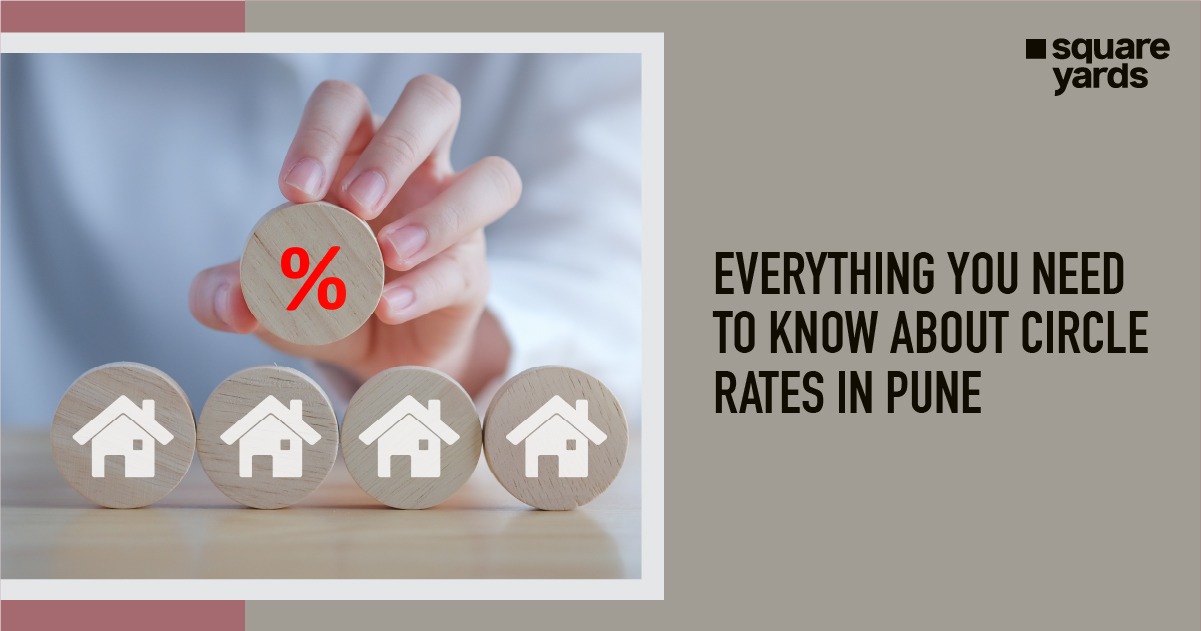Understanding the real estate market is crucial for buyers, sellers, and investors. One key component in this regard is the circle rate, also known as the ready reckoner rate. In Pune, the government periodically updates these rates to reflect current market trends. This blog presents the most recent updates on circle rates in Pune for 2024-2025, providing an overview, details on how they are determined, and their significance in real estate transactions.
Table of contents
- Overview of Circle Rates in Pune
- Understanding Circle Rates in Pune
- Ready Reckoner Rates for Various Areas in Pune
- Latest Circle Rates for Commercial Property in Pune
- 5 Factors Influencing Circle Rates in Pune
- How Do You Check Ready Reckoner Rates in Pune?
- Key Takeaways on Circle Rates in Pune
- FAQ’s about Circle Rate in Pune
Overview of Circle Rates in Pune
Circle rates, or ready reckoner rates, are the minimum property values the government sets for a specific area. These rates are used as a benchmark for calculating property registration charges and stamp duty. Circle rates in Pune vary from one locality to another, reflecting the differences in real estate values across the city. The government revises these rates annually to keep pace with the changing market conditions, ensuring fair valuation and preventing underreporting of property values.
Understanding Circle Rates in Pune
Circle rates serve as a crucial reference point for property transactions. They are determined based on several factors, including the locality, type of property (residential or commercial), and the amenities available in the area. The circle rates in Pune ensure real estate market transparency and curb black money transactions. By setting a floor price, the government ensures that properties are not undervalued during sales and purchases.
Ready Reckoner Rates for Various Areas in Pune
The ready reckoner rates in Pune vary significantly across different localities. Prime areas have higher circle rates due to their premium status and excellent infrastructure, while suburban areas have relatively lower rates. Here are some examples of ready reckoner rates in various parts of Pune:
| Place | Flats/Apartments (Rs./sq.m) | Residential Lands (Rs./sq.m) |
| Ambegaon Khurd | 47,720 – 49,890 | 19,540 |
| Baner | 42,760 – 83,830 | 19,690 – 31,800 |
| Hadapsar | 38,180 – 80,930 | 16,700 – 29,700 |
| Kothrud | 68,320 – 1,14,570 | 20,530 – 44,730 |
| Kharadi | 41,240 – 71,880 | 8,040 – 29,960 |
| Bibvewadi | 45,290 – 95,160 | 8,340 – 35,300 |
| Balewadi | 47,100 – 73,010 | 17,830 – 29,480 |
| Dhanori | 26,890 – 59,080 | 8,720 – 20,790 |
| Lohegaon | 36,040 – 75,420 | 8,180 – 28,750 |
| Yerwada | 42,380 – 97,350 | 13,330 – 46,370 |
Latest Circle Rates for Commercial Property in Pune
Commercial properties in Pune also have designated circle rates, which are typically higher than residential rates due to the higher revenue potential of commercial spaces. Central business districts’ circle rates for commercial properties are significantly elevated. For example:
| Place | Office Space (Rs./sq.m) | Shops (Rs./sq.m) |
| Ambegaon Khurd | 47,250 – 51,080 | 49,910 – 55,720 |
| Baner | 62,080 – 101,480 | 81,130 – 144,770 |
| Hadapsar | 52,760 – 85,000 | 62,000 – 137,080 |
| Kothrud | 69,930 – 152,810 | 79,700 – 260,700 |
| Kharadi | 42,440 – 83,370 | 50,920 – 92,470 |
| Bibvewadi | 50,310 – 139,480 | 76,740 – 211,220 |
| Balewadi | 58,820 – 85,090 | 75,000 – 121,340 |
| Dhanori | 46,640 – 86,190 | 56,290 – 118,630 |
| Lohegaon | 40,950 – 96,650 | 49,140 – 115,900 |
| Yerwada | 62,000 – 166,580 | 75,810 – 243,730 |
Circle Rate in Others Cities:
| Circle Rate in Gurgaon | Circle Rate in Lucknow |
| Circle Rate in Faridabad | Circle Rate in Delhi |
| Circle Rate in Mumbai | Circle Rate in Ghaziabad |
5 Factors Influencing Circle Rates in Pune
Several factors influence the determination of circle rates in Pune:
- Location: Proximity to key infrastructure and amenities such as schools, hospitals, and transportation hubs.
- Development: The level of urban development and availability of modern facilities in the area.
- Market Trends: Prevailing real estate market trends and demand-supply dynamics.
- Property Type: Differences between residential, commercial, and industrial properties.
- Government Policies: Regulatory changes and government initiatives impacting real estate.
These factors collectively ensure that the circle rates reflect the true market value of properties in Pune.
How Do You Check Ready Reckoner Rates in Pune?
Checking the ready reckoner rates in Pune is a straightforward process. The Maharashtra government publishes these rates annually, and they are available on the official website of the Department of Registration and Stamps. Users can follow these steps:
- Visit the IGR Maharashtra Website: Go to IGR Maharashtra.
- Navigate to the Stamps Section: Locate and select the e-ASR option.
- Choose e-ASR 1.9 Version: Ensure you select the correct version for accurate information.
- Use the Map: Select Pune on the map.
- Refine Your Search: Choose the specific taluka and village to view the needed Annual Statement of Rates.
Key Takeaways on Circle Rates in Pune
The government sets circle rates, also known as ready reckoner rates, to ensure fair property valuation, which varies significantly across Pune’s 19 zones and 221 sub-zones based on market value and available amenities. These rates differ for residential and commercial properties, with the latter generally having higher rates. Key factors influencing these rates include location, development, market trends, property type, and government policies. To check the Circle Rates in Pune, users can visit the IGR Maharashtra website, navigate to the e-ASR section, and select the specific taluka and village.
FAQ’s about Circle Rate in Pune
What is the current circle rate in Pune?
The circle rate in Pune varies based on location and property type. It is set by the government and serves as the minimum property valuation for stamp duty and property registration.





